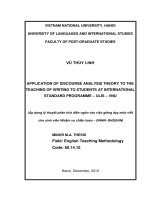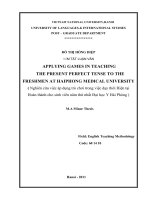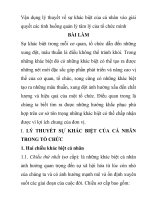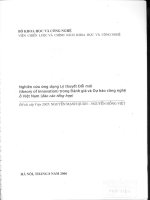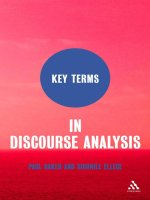Application of cohesion theory in discourse analysis to the teaching of reading comprehension to foreign language learners = Áp dụng lý thuyết về liên kết văn b
Bạn đang xem bản rút gọn của tài liệu. Xem và tải ngay bản đầy đủ của tài liệu tại đây (5.38 MB, 74 trang )
VIETNAM NATIONAL UNIVERSITY, HANOI
UNIVERSITY OF LANGUAGES AND INTERNATIONAL STUDIES
FACULTY OF POST-GRADUATE STUDIES
BỒ THỊ LÝ
APPLICATION OF COHESION THEORY IN DISCOURSE
ANALYSIS TO THE TEACHING OF READING
COMPREHENSION TO FOREIGN LANGUAGE LEARNERS
(Áp dụng lý thuyết về liên kết văn bản trong việc dạy đọc hiểu tiếng Anh cho
học viên học Tiếng Anh như một ngoại ngữ)
MINOR M.A. THESIS
Field: English Teaching Methodology
Code: 60.14.10
Hanoi, December, 2012
VIETNAM NATIONAL UNIVERSITY, HANOI
UNIVERSITY OF LANGUAGES AND INTERNATIONAL STUDIES
FACULTY OF POST-GRADUATE STUDY
BỒ THỊ LÝ
APPLICATION OF COHESION THEORY IN DISCOURSE
ANALYSIS TO THE TEACHING OF READING
COMPREHENSION TO FOREIGN LANGUAGE LEARNERS
(Áp dụng lý thuyết về liên kết văn bản trong việc dạy đọc hiểu tiếng Anh cho
học viên học Tiếng Anh như một ngoại ngữ
MINOR M.A. THESIS
Field: English Teaching Methodology
Code: 60.14.10
Supervisor: Huỳnh Anh Tuấn, PhD
Hanoi, December, 2012
iv
TABLE OF CONTENT
Table of contents Page
Declaration i
Acknowledgements ii
Abstract iii
Table of content iv
Lists of tables, figures and abbreviations vi
Part A: INTRODUCTION
I. Rationale 1
II. Aims 2
III. Scope of the study 2
IV. Research methodology 3
V. Significance of the study 5
PART B: DEVELOPMENT
Chapter I: THEORETICAL BACKGROUND and LITERATURE REVIEW
I. Theoretical background
1.1. RAND Model of reading comprehension 7
1.2. Previous approaches to teaching reading comprehension 9
1.3. Discourse and discourse analysis 12
1.4. Cohesion and coherence 13
1.5. The role of cohesion competence in reading comprehension 17
II. Literature Review 19
Chapter II: Methodology
2.1. Research questions 21
v
2.2 Research approach 21
2.3. Data collection methods 21
2.4. Data analysis methods 28
Chapter III: Data Analysis: Results, Discussions and Recommendations
3.1 Results and discussions 31
3.1.1 Student‘s pre-existing knowledge about cohesion and coherence 31
3.1.2. Students‘ level of improvement in reading comprehension 33
3.2 Recommendations 35
PART C: CONCLUSION
I. Major findings of the study 38
II. Limitations of the study 39
III. Suggestions for further studies 39
IV. Contributions of the studies 40
REFERENCES
APPENDICES
LISTS OF TABLES, FIGURES AND ABBREVIATIONS
List of tables:
Table 3.1
Descriptive Statistics for the group‘s performance in the
pre-test and post-test.
Table 3.2
Results of the Paired-Sample T-tests
vi
List of figures
Figure 1.1
The RAND model of reading comprehension. From
Reading for Understanding: Toward an R&D Program in
Reading Comprehension, by RAND Reading Study Group
(p. 12), 2002, Santa Monica, CA: RAND. Copyright 2002
by RAND.
Figure 3.1
Number of students who have learnt and have not leant
about cohesion
Figure 3.2:
Importance of cohesion in a written text
Figure 3.3:
Necessity of understanding cohesion in comprehending a
text?
Figure 3.4:
Effectiveness level of the experimental teaching course.
List of abbreviations:
L1: First language
ISP: the International Standard Program
1
PART A: INTRODUCTION
I. Rationale
It is widely known that reading is very important for almost everyone,
especially for second language learners. According to Tomlinson (1990), a good
reading competence is a necessity for those using English for academic and
occupational purposes and many curricula therefore devote large amounts of time
to intensive and extensive reading lessons in order for their learners to achieve
such competence.
As a result, teaching English reading has been always the focus of much
concern. However, after a great deal of research has been done in this aspect, we
are aware that many students, though having learnt English for years, often end in
failure about their comprehension when asked to read a passage. After years of
practice in reading, many learners still find it difficult to make sense of the texts
they want to read. One of the reasons is, as pointed out by many scholars such as
Cook (1989) and Nuttal (1982), the failure to interpret the writer‘s cohesive
signals as intended and so to understand correctly the functional value of
individual sentences as thus their relationship to each other and the whole.
In the view of Halliday and Hasan (1976) the continuity that cohesive
relations bring about is a semantic continuity. This makes it possible for cohesive
patterns to play an indispensable role in the processing of text by a listener or
reader. It is, therefore, necessary to help our students identify different kinds of
cohesive relations which form the backbones of different types of text, because
those chains signal organizational patterns of different types of text.
All these conditions stimulated the researcher to conduct a study on
“Application of cohesion theory in discourse analysis to the teaching of reading
2
comprehension to foreign language learners”. This is an action research in which
the researcher taught reading comprehension by applying cohesion theory in the
lessons and guide students to use the knowledge conveyed to enhance their
reading ability.
II. Aims
As mentioned above, the knowledge about cohesion may assist students‘
comprehension of a reading text. Therefore, the study aims to investigate the effect
of cohesion competence on students‘ reading comprehension.
In order to fulfill such an aim, two main objectives were set for the study.
Firstly, the study was expected to provide an insight into students‘ prior
knowledge about cohesion and cohesion in reading. Secondly, the researcher
expected to find out whether the teaching of cohesion to students could improve
their reading ability.
III. Scope of the study
Although the title of the research is generally ―cohesion theory‖, this paper
mainly focuses on analyzing types of cohesion that appeared in reading texts.
Furthermore, the teaching of cohesion in reading does not only mean the
researcher would teach cohesion theoretically but also by analyzing and guide
student to analyze cohesive items in reading passages. In addition, the researcher
adapted the reading passages in the reading course book for B1 level namely Issue
For Today 3 combined with several further practices as homework instead of
providing new out-book reading materials for in-class practice.
3
The informants of the study were 24 non-English majored first year students.
They were all of B1 level of English according to the Common European
Framework of Reference. The participating students were in the same class to
whom the researcher was in charge of teaching reading.
IV. Research methodology
1. Research questions
The study was conducted to address the following two research questions:
1. What kind of prior knowledge did the students in the study have in terms
of cohesion and cohesion in reading comprehension before the experimental
teaching phase?
2. How does the teaching of cohesion improve the reading comprehension
of second language learners?
2. Research approach
To address the two research questions, action research was adopted as the
research approach as it meets the aim and objectives of the study. This approach is
also justified to offer significant benefits for the researcher, who is also a teacher.
Johnson (1995) pointed out three mains advantages of action research namely to
promote personal and professional growth, to improve practice to enhance student
learning, and to advance the teacher profession.
3. Data collection instruments
The four main instruments for data collection used in the study were
observation and field notes, reading comprehension tests, and survey
questionnaires.
4
An observation checklist was particularly designed to assess the students‘
participation and motivation in the reading lesson. The researcher based on the
observation checklist and takes notes about the students‘ performance in the class.
There are two reading comprehension tests, namely a pre-test taken before the
intervention and a post-test taken after the intervention. Both tests were of the
same level of difficulty regarding timing, number of questions, number of text,
length, passage structure and vocabulary level.
Two survey questionnaires were designed to gain data for the research. One
questionnaire was sent out before the intervention to find information about
students‘ prior knowledge, experience and belief in learning cohesion. The other
was distributed after the intervention to collect data about students‘ attitude
towards the experimental teaching.
4. Data collection procedure
The data collection was conducted through 3 phases including pre-
intervention, while-intervention and post-intervention. The data collection
instruments were adopted flexibly for each phase as illustrated in the timeline
below:
Pre- intervention
While – intervention
(6 weeks)
Post- intervention
Survey questionnaire
Observation
Survey questionnaire
Pre-test
Field notes
Post-test.
The survey questionnaires and reading comprehensions tests went through
three stages regarding piloting, delivering and collecting. Observation and field
5
notes were taken during the six-week experimental teaching phase to assess
students‘ motivation and participation in the reading lessons.
5. Data analysis methods
Both quantitative and qualitative methods were utilized to analyze the data
collected. Specifically, quantitative method was used to analyze objective data
from tests and survey questionnaires. Meanwhile, qualitative method was for data
from field notes and open-ended questions in the survey questionnaires.
Furthermore, statistical analysis was employed to analyze the data collected.
Simple descriptive statistics is the most suitable method to present the finding of
this study in terms of the study scope as well as the researcher‘s own capabilities.
V. Significance of the study
In general, teachers, educational administrators and researchers working on
related issues could gain certain benefits from the study. First, the researcher was
provided a precious chance to reflect her own teaching, to investigate a new
teaching strategy and raise other teachers‘ awareness of such a strategy.
Besides, this research could offer references about updated and reliable
information about a context of applying cohesion in teaching reading skills for
second language learners to interested individual to conduct further studies.
6
PART B: DEVELOPMENT
CHAPTER 1: THEORETICAL BACKGROUND AND
LITERATURE REVIEW
I. Theoretical background
1.1. RAND Model of reading comprehension
Researchers and linguists have presented different definitions on the concept
of reading, ranging from the simple to complicated ones. According to Durkin
(1993: 37), reading is ―intentional thinking during which meaning is constructed
through interaction between text and reader‖. Similarly, Harris & Hodges (1995:
26) see reading as a process of constructing meaning of a written text through ―…a
reciprocal interchange of ideas…‖ between the reader and the text.
More expansively, reading is a complicated process of ―simultaneously
extracting and constructing meaning through interaction and involvement with
written language‖ which engages different factors as pointed out by Rand Reading
Study Group (2002): the reader, the text and the activity or purpose for reading.
This is one of the most comprehensive definitions of reading as it describes
reading with its specific elements. Reading is not the unilateral activity of readers
but an active interaction between the reader and the text in which the salience of
both the text (extracting meaning) and the reader (constructing reading) through
interaction (the activity) with written language is emphasized.
Below is the model of reading comprehension by RAND (2000)
7
Figure 1. The RAND model of reading comprehension. From Reading for
Understanding: Toward an R&D Program in Reading Comprehension, by RAND
Reading Study Group (p. 12), 2002, Santa Monica, CA: RAND. Copyright 2002 by
RAND.
Reader. The reader factor includes:
cognitive capacities: attention, memory, critical analytic ability, inferencing,
visualization ability
motivation : a purpose for reading, an interest in the content being read, self-
efficacy as a reader
various types of knowledge : vocabulary, domain and topic knowledge,
linguistic and discourse knowledge, and knowledge of specific
comprehension strategies
Text. The text features that impact comprehension, including:
Genre
Structure: the organization of the text and
the overall coherence: degree of similarity of ideas from one sentence to the
next
Media forms
8
Sentence difficulty: including vocabulary and syntax
Content
Activity: This factor consists of 3 elements
Purpose/task: skimming for gist, studying to retain information….
Operations to process the text : decoding, higher-level linguistic and
semantic processing, or self-monitoring for comprehension).
Outcomes of performing activity: an increase in knowledge, a solution to
real-world problem, or increased engagement with text.
As can be clearly seen, from the simple to the complex definitions, reading is
understood as abroad term that covers reading comprehension. In other words,
reading comprehension is not a separate process but a component stage in the
multi-element process of reading. To sum up, reading is a multi-component
process which involves a ―…triangular relation…‖ between reader, author and the
text rather than a linear transmission of meaning from author to reader (Lunzer,
E.A and Gardner, K, 1979).
1.2. Previous approaches to teaching reading comprehension
Three teaching approaches are proposed and discussed for their respective
benefits and drawbacks: bottom-up, top-down and interactive reading.
1.2.1 Bottom-up reading approach
Bottom-up approach focuses on the text as the convergence of encoded
messages to be deciphered. Instructors who uphold bottom-up processing focus on
how learners extract information from the printed page, and on whether or not
learners deal with letters and words in a systematic fashion. Therefore, the goals of
the bottom-up approach are automatic word recognition and rapid reading rate. To
9
reach the aims, explicit instruction in phonetics and spellings is crucial; students
should not be ―word-bound‖ in bottom-up processing (Grabe, 1991).
This bottom-up teaching approach has been proved of its effectiveness
through eye-movement experiment, and been realized in Grammar-Translation
Method, in which native language may be adopted to translate the target language
to make sense the whole verbal construction. From the bottom-up viewpoint,
therefore, reading is a process of decoding written symbols into their aural
equivalents. It‘s a text-centered move in which texts are the containers of rules and
codes to be deciphered. Specifically speaking, in this lower-level reading process
(Grabe 1991), readers are passive recipients of textual information. During the
decoding process, understanding the hierarchal, linguistic structures of the
language promises reading comprehension. The focus is never the meaning of the
whole text, but detailed linguistic forms—from phoneme to lexical, syntactic
levels.
1.2.2 Top-down reading approach
As to top-down teaching approach, the learner‘s prior knowledge is activated,
which is capable of enhancing learner‘s language learning, and making possible
reading comprehension. In other words, in top-down approach, content schemata,
or background knowledge, are to be activated; prior knowledge plays a major role
in learner‘s comprehension. Carrell (1988) argued that a lack of content schemata
activation would lead to insurmountable processing difficulties with second
language readers. Hudson (1982) has even argued that a high degree of
background knowledge can overcome linguistic deficiency. In addition to prior
knowledge as a key point, top-down model is actually a whole-language teaching
approach, in which readers focus on the context, and manage to construct
meanings in the text (Treiman, 2001). In this sense, top-down reading strategies
10
contain predicting, inferring, and focusing on meanings (Grabe 1991). Reading is
actually ―a psychological guessing game‖, in the words of Goodman (1970: 45).
1.2.3 Interactive Reading approach
Kern (2000) defined reading as a dynamic, interactive process which
produced meanings and derived discourse from texts. Reading is an active,
constructive, and meaning-making process. Therefore, reading comprehension is
generally associated with the ability to read, and to construct meanings as well
(Fielding & Pearson, 1994).
Iser (1980) further developed the cognitive view of reading to reader-
response theory. In reading process, readers stand at the center; readers‘ prior
knowledge and textual reading interact. Meanings are thus eventually incited in
this way. There is a dynamic relationship between reader and text, in which
reading is a creative process rather than a textual decoding only. The reader is
therefore granted an authorial role.
Therefore, the interactive model for teaching and reading refers to the
dynamic relationship between bottom-up and top-down, between decoding and
interpretation, and between text and reader. This approach is best applied to
teaching literary works because the reading/teaching goals—interpretation and
meaning construction—are likely to be reached, and the reader/learners are not
excluded from the text/learning process.
1.3. Discourse and discourse analysis
Discourse analysis, as remarked by Brown and Yule (1983:8), ―has come to
be used with a wide range of meanings which cover a range of activities at the
intersection of many disciplines from sociolinguistics, philosophical linguistics to
computational linguistics‖. In other words, discourse analysis is a field of study
11
which concerns different aspects basically including three basic strands; that is
text grammar, conversation analysis, and pragmatics, as pointed out by Hoa
Nguyen (2000:11). He also defines discourse analysis, in the eyes of a linguist, as‖
a study of how and for what purposes language is used in a certain context of
situation and the linguistic means to carry out these purposes.‖
In the study of discourse analysis, it is crucial to make a clear distinction
between two terms: discourse and text.
According to Brown and Yule (1983:6), text is ―the verbal record of a
communicative act‖; meanwhile, discourse …. ―is language in use‖…(p.1). De
Beaugrande and Dressler (1981) presents an elaborate definition of text as a
―communicative occurrence which possesses seven constitute conditions of textual
communication, cohesion, coherence, intentionality, acceptability, informability,
situationality and intertextuality‖. In this approach, De Beaugrande and Dressler
see text and discourse in the same light.
The most explicit and clearest distinction is by Widowson (1984). He
elaborates discourse as ―a communicative process by means of interaction. Its
situational outcome is a change in a state of affair: information is conveyed,
intention made clear, its linguistic product is Text‖ (as cited in Hoa Nguyen, 2000,
p.14). In the explanation, text is understood as simply a representation of a
communicative process. In other words, text is the verbal realization of discourse.
1.4 Cohesion and Coherence
Basically, cohesion can be thought of as all the grammatical and lexical links
that link one part of a text to another. According to Linke et. all (2004: 245),
cohesion refers to the ―relations between sentences that are indicated by explicit
syntactic or semantic ties between linguistic element‖ Halliday & Matthiessen
(2004:523) provide a more comprehensive elaboration of cohesion; that is:
12
“set of lexico-grammatical systems that have evolved specifically as a
resources for making it possible to transcend the boundaries of the clause-
that is the domain of the highest-ranking grammatical unit.”
Coherence, on the other hand refers to the semantic relations that underline
texts. Van Dijk (1979:93) writes:
“Coherence is a semantic property of discourse formed through the
interpretation of each individual sentence relative to the interpretation of
other sentences, with “interpretation” implying interaction between the text
and the reader”
With this definition, Van Dijk (1979) highly relates coherence with the
interpretation of the text. However, the text here is limited to written texts, not
covering spoken texts.
Palmer (1983) defines coherence as the type of rhetorical relationships
terms of both written and spoken texts, that is‖ coherence refers to the
rhetorical devices, to ways of writing and speaking that bring about order an
unity and emphasis‖.
Blum-Kulka (1986: 17) provides an elaboration which covers both the
ideas of Palmer (1983) and Van Dijk (1979); that is, coherence is viewed as ―a
covert potential meaning relationships among parts of a text, made overt by the
reader or listener through processes of interpretation‖.
Briefly put, a text has cohesion, or is cohesive if its elements are tied
together with explicit linguistic marking of meaning relation. Meanwhile, a
text has texture, or is coherent, if it makes sense. In other words, it builds up
mental creation of meaning relations during text processing.
13
1.4.1 Type of cohesion
1.4.1.1 Grammatical Cohesion
1.4.1.1.1 Reference
According to Halliday and Hasan (1976:32), reference is a semantic relation
and ―since the relationship is on semantic level, the reference item is in no way
constrain to match the grammatical class of the item it refers to‖. The two scholars
also classify discourse reference into two types, namely exophoric and endophoric.
If the reference item is endophoric, it can be either anaphoric or cataphoric.
Anaphoric reference occurs when the writer refers back to someone or something
that has been previously identified, to avoid repetition. It points the listeners and
readers backward to previous entity to understand the text. In constrast, cataphoric
reference lead listeners and readers forward to the text.
Exophoric reference is different from these two types by describing generics
or abstracts without ever being identified. In this case, the interpretation is assisted
by the context of the situation.
Reference items in English comes into three main forms, including personal
reference expressed by pronouns (he, she, it, me, mine…) and determiners (his,
her, your…); demonstrative reference (this, that, there, then, etc.) and comparative
reference which is expressed by adjectives and adverbs such as same, identical,
equal, different, other, etc.
1.4.1.1.2 Substitution
Halliday and Hasan (1976:89) define substitution as ―a relation between
linguistic items such as words or phrases and in terms of linguistic level, it is a
relation on the lexico-grammar level, the level of grammar and vocabulary‖. Hoa
14
Nguyen (2000: 24) also sees substitution as ―a device which shows the relation
between sentences, where it is derivable to avoid repetition‖
In this light, Halliday and Hasan (1976) categorized substitution into nominal,
verbal and clausal substitution. Nominal substitution is realized by one, ones, and
same. Verbal substitute in English is ―do‖ and clausal substitutes are ―so‖ and not.
Clausal substitution is commonly used after verbs: think, hope, suppose, etc.
1.4.1.1.3 Ellipsis
In Halliday and Hasan (1976:142)‘s point of view ellipsis is ―the omission of
certain elements from a sentence, allowed by context‖. It is important to make a
difference between ellipsis and substitution. With ellipsis, the omitted parts can be
recovered based on the context but such possibility does not exist.
Quirk et all (1972) discuss three conditions under which ellipsis may occur
namely, repetition, expansion and replacement.
a. Repetition: the speaker repeat what has been said by the first
E.g/ Did you go there?
Yes, I did (go there)
b. Expansion: the speakers adds to what has been said
E.g/ Will he come?
Probably (he will come)
c. Replacement: the second speaker replaces what has been said by the first
with new information
E.g/ Where did he go?
(He went to) Canada.
1.4.1.1.4 Conjunction
15
According to Cook (1989:21), ―conjunction is words or phrases which
explicitly draw attention to the type of relationship between one sentence and
clause and another‖. Briefly speaking, conjunctions are used to connect sentences
and clauses together into one context.
Halliday and Hasan (1976: 242-243) divide conjunction into four types
including additive, adversative, causal and temporal.
a. additive: the relation of adding meaning among sentences
E.g/ and, also, moreover, in addition, etc
b. adversative: information appears in the contradict way
E.g/ but, yet, though, however, on the contrary, etc
c. causal: the relation of cause and effect
E.g/ so, hence, before, consequently, as a result, etc
d. temporal: this relation creates unified and tied discourse.
E/g : then, next, last, etc…
1.4.1.2 Lexical cohesion
According to Van (2006:80-81), the concept of lexical cohesion was first
defined in terms of collocation by Firth (1975), then developed by Halliday and
Hasan (1976). Eggins (1994) and Halliday (1985) share the same idea that lexical
relation analysis is a way of systematically describing how words in a text related
to each other, how they cluster to build up lexical sets or lexical strings. Lexical
relation appears in two main types, reiteration and collocation.
1.4.1.2.1 Reiteration
According to Mc Carthy (1991:65) presents that ―reiteration means either
restating an item in a later part of discourse by direct repetition or else reasserting
16
its meaning by exploiting lexical relations‖. Reiteration is divided into five types,
namely repetition, synonyms, super-ordinate and general words.
1.4.1.2.2 Collocation
Collocation occupies an important role in lexical items to create cohesion in a
text. In fact, words seldom stand alone, but tend to combine together and relate to
each other. According to Halliday and Hasan (1976), ―Word combination‖ or
―word co-occurrence‖ is known as collocation which brings a particular sense or
meaning.
1.4.2 The role of cohesion competence in reading comprehension
Halliday and Hasan (1976) propose that the distinction between a text and a
nontext is the existence of texture which is primarily provided by cohesion and
―since the speaker and writer uses cohesion to signal texture, the listener and the
reader has to react to it in order to interpret it‖. In the view of the two scholars the
continuity that cohesive relations bring about is a semantic continuity. The
importance of cohesion lies in the continuity it expresses which is necessary for
the interpretation of the text. Yue (1993) points out the 4 roles of cohesions in
assisting reading comprehension.
1. Cohesion provides the main thread of a text by showing that some entity or
circumstance, some relevant feature or argument persists from one moment
to another in the semantic process as meaning unfold.
2. Cohesion creates the characteristic ―feel‖ of a text. The continuity expressed
by cohesion not only makes a text interpretable, it also provides it with its
affective power.
17
3. Cohesion enables readers to supply all the missing items necessary for the
interpretation of a text.
4. Cohesion provides the basis for making predictions and building
expectation.
18
II. LITERATURE REVIEW
Within the recent decades, there have been numerous researches on cohesion,
coherence and EFL reading worldwide, in which many have shown the important
role played by cohesion and coherence in facilitating reading comprehension.
Chapman (1983) finds a relationship between reading ability and the ability
to complete anaphoric relation in a cloze test, and he concludes that the masters of
such textual features- including cohesive ties (Halliday and Hasan, 1976)- is a
central factor in fluent reading and reading comprehension. Mackay (1979) and
Cowan (1976) similarly argue that the recognition of conjunctions and other
intersentential linguistic devices is crucial to the information gathering skills of
second language readers. As a result, the teaching of reading should include
classroom instruction on the cohesive devices of English, and their function across
sentences and paragraphs.
William (1983) not only discusses the importance of recognizing cohesive
ties in reading in a foreign language, but also suggests teaching materials and
methods to bring this about. Specifically, he proposes a system of symbols and
textual markings that teach foreign readers how to use cohesive signals in order to
increase their reading comprehension and its relationships to reading development.
In the study ―Cohesion and the teaching of EFL reading‖, Fulcher (1987)
determines the roles of cohesion in assisting reading comprehension. The scholar
also states that cohesion plays a crucial role on the interpretation of a text.
Muto, Keiko (2007) in his study named ―The Use of Lexical Cohesion in
Reading and Writing‖ provokes the considerable effect that the knowledge of
lexical cohesion has on their understanding of the story. The necessary
information, which authors hint at in the text, could be exposed by paying
attention to the cohesive ties among words. There were, however, occasions when
19
L2 learners needed to improve in order to make the general knowledge of lexical
cohesion more useful for reading: acquiring cultural knowledge, expanding the
area of lexical cohesion to the whole text, creating original.
Many researchers have come to the conclusion that all types of textual
cohesive conjunctions facilitate reading comprehension in the same way (Cooper
(1984); Chung (2000); Degand & Sanders 2002).
Overall, it can be seen clearly that these aforementioned findings are
inarguably illuminating and valuable in the world. However, as far as concerned,
such researches have remained limited in the context of Vietnam.
First, cohesion and coherence have been widely studied as an aspect of
linguistics field by Vietnamese researchers. To be more specific, almost studies
related to cohesion are associated with analyzing cohesive items in well-known
texts or contrasting the use of cohesion in Vietnamese and English written texts. In
other word, most studies on cohesion and coherence belong to linguistics and
contrastive analysis. Little has been done in the field of teaching methodology.
Second, in terms of cohesion and coherence, Vietnamese researchers have
given considerable attention to EFL writing rather than EFL reading as one of
essential criteria for assessing writing, coherence and cohesion.
All these aforementioned conditions have motivated the researcher to conduct
an action study on the cohesion and EFL reading teaching in the context of
Vietnam.
20
CHAPTER 2: RESEARCH METHODOLOGY
2.1 Research questions:
The research is conducted to address the following two research questions:
1. What kind of prior knowledge did the students in the study have in terms of
cohesion and cohesion in reading before the experimental teaching phase?
2. How does the teaching of cohesion improve the reading comprehension of
second language learners?
2.2 Research approach
Action research was adopted as the research approach to firstly answer the
two research questions and finally achieve the aim and objectives of the study.
According to Ferrance (2000), action research is a suitable method for teachers
who want to make appropriate changes to student learning and measure the
possible effects. Ferrance (2000:27) demonstrates ―Action research is used to chart
the effects of implementation of a curriculum or strategy, to study student learning
and responses.‖ . This method is also justified to offer significant benefits for the
researcher, who is also a teacher. Johnson (1995) pointed out three mains
advantages of action research namely to promote personal and professional
growth, to improve practice to enhance student learning, and to advance the
teacher profession.
2.3 Data collection methods
2.3.1 Informants




